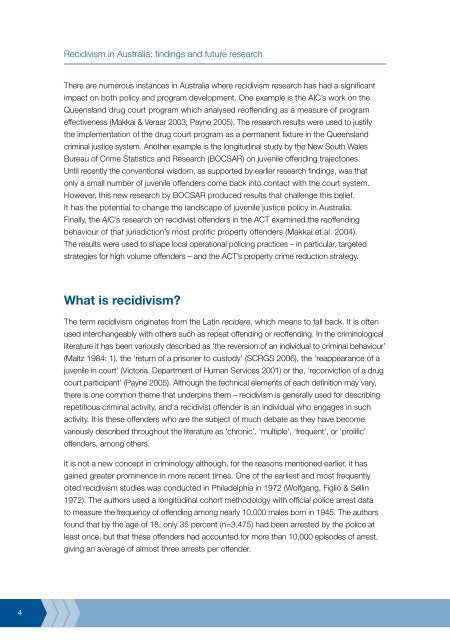Recidivism in Australia : findings and future research - Australian ...
Recidivism in Australia : findings and future research - Australian ...
Recidivism in Australia : findings and future research - Australian ...
You also want an ePaper? Increase the reach of your titles
YUMPU automatically turns print PDFs into web optimized ePapers that Google loves.
4<br />
<strong>Recidivism</strong> <strong>in</strong> <strong>Australia</strong>: f<strong>in</strong>d<strong>in</strong>gs <strong>and</strong> <strong>future</strong> <strong>research</strong><br />
There are numerous <strong>in</strong>stances <strong>in</strong> <strong>Australia</strong> where recidivism <strong>research</strong> has had a significant<br />
impact on both policy <strong>and</strong> program development. One example is the AIC’s work on the<br />
Queensl<strong>and</strong> drug court program which analysed reoffend<strong>in</strong>g as a measure of program<br />
effectiveness (Makkai & Veraar 2003; Payne 2005). The <strong>research</strong> results were used to justify<br />
the implementation of the drug court program as a permanent fixture <strong>in</strong> the Queensl<strong>and</strong><br />
crim<strong>in</strong>al justice system. Another example is the longitud<strong>in</strong>al study by the New South Wales<br />
Bureau of Crime Statistics <strong>and</strong> Research (BOCSAR) on juvenile offend<strong>in</strong>g trajectories.<br />
Until recently the conventional wisdom, as supported by earlier <strong>research</strong> f<strong>in</strong>d<strong>in</strong>gs, was that<br />
only a small number of juvenile offenders come back <strong>in</strong>to contact with the court system.<br />
However, this new <strong>research</strong> by BOCSAR produced results that challenge this belief.<br />
It has the potential to change the l<strong>and</strong>scape of juvenile justice policy <strong>in</strong> <strong>Australia</strong>.<br />
F<strong>in</strong>ally, the AIC’s <strong>research</strong> on recidivist offenders <strong>in</strong> the ACT exam<strong>in</strong>ed the reoffend<strong>in</strong>g<br />
behaviour of that jurisdiction’s most prolific property offenders (Makkai et al. 2004).<br />
The results were used to shape local operational polic<strong>in</strong>g practices – <strong>in</strong> particular, targeted<br />
strategies for high volume offenders – <strong>and</strong> the ACT’s property crime reduction strategy.<br />
What is recidivism?<br />
The term recidivism orig<strong>in</strong>ates from the Lat<strong>in</strong> recidere, which means to fall back. It is often<br />
used <strong>in</strong>terchangeably with others such as repeat offend<strong>in</strong>g or reoffend<strong>in</strong>g. In the crim<strong>in</strong>ological<br />
literature it has been variously described as ‘the reversion of an <strong>in</strong>dividual to crim<strong>in</strong>al behaviour’<br />
(Maltz 1984: 1), the ‘return of a prisoner to custody’ (SCRGS 2006), the ‘reappearance of a<br />
juvenile <strong>in</strong> court’ (Victoria. Department of Human Services 2001) or the, ‘reconviction of a drug<br />
court participant’ (Payne 2005). Although the technical elements of each def<strong>in</strong>ition may vary,<br />
there is one common theme that underp<strong>in</strong>s them – recidivism is generally used for describ<strong>in</strong>g<br />
repetitious crim<strong>in</strong>al activity, <strong>and</strong> a recidivist offender is an <strong>in</strong>dividual who engages <strong>in</strong> such<br />
activity. It is these offenders who are the subject of much debate as they have become<br />
variously described throughout the literature as ‘chronic’, ‘multiple’, ‘frequent’, or ‘prolific’<br />
offenders, among others.<br />
It is not a new concept <strong>in</strong> crim<strong>in</strong>ology although, for the reasons mentioned earlier, it has<br />
ga<strong>in</strong>ed greater prom<strong>in</strong>ence <strong>in</strong> more recent times. One of the earliest <strong>and</strong> most frequently<br />
cited recidivism studies was conducted <strong>in</strong> Philadelphia <strong>in</strong> 1972 (Wolfgang, Figlio & Sell<strong>in</strong><br />
1972). The authors used a longitud<strong>in</strong>al cohort methodology with official police arrest data<br />
to measure the frequency of offend<strong>in</strong>g among nearly 10,000 males born <strong>in</strong> 1945. The authors<br />
found that by the age of 18, only 35 percent (n=3,475) had been arrested by the police at<br />
least once, but that these offenders had accounted for more than 10,000 episodes of arrest,<br />
giv<strong>in</strong>g an average of almost three arrests per offender.















